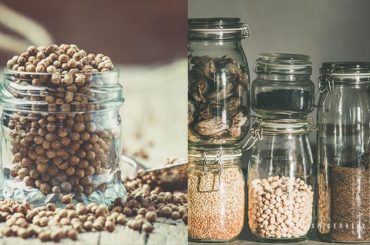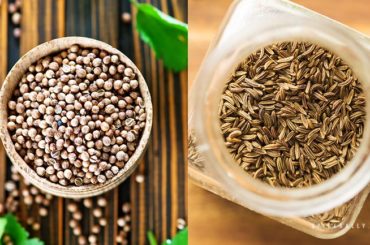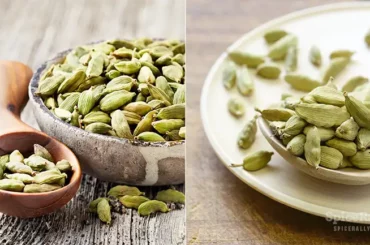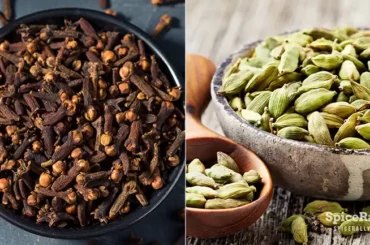Black and white pepper (Piper Nigrum) are two variations of the pepper plant fruit (family Piperaceae). They differ from each other only through the processing steps after being hand-picked. They blend with day-to-day menus plus appetizing desserts on your dining table.
Let’s figure out some core differences of black versus white pepper below.
Black pepper vs White pepper: uncover the difference
Black pepper is produced by picking mostly the still-green (sometimes ripened) peppercorn from the plant, sun-dried until the outer covering turns black with wrinkles.
Conversely, white pepper is processed by removing the outer layer of mature fruit ( before or after drying), soaking in water, and taking out the seed inside. Here, devoid of the outer skin strips away some piperine and chemicals making the seed milder with the barnyard smell.

You may be surprised to know about the nutritional facts, here’s how it goes.
In general, Black pepper is abundant in vitamins(B6, B1, B3), minerals, manganese, calcium, with a bulk of potassium.
While White pepper is enriched with iron and vitamin c. Both carry wonderful benefits to health immensely. Being aware and grasping the necessary amounts without going overboard is up to you.
Black and white is salt and pepper of colors for life, taste bland without them
Famous Author Vikrmn , Corpkshetra
Black pepper delivers a hot and pungent taste with a slightly musty odor while the other contains a hotter but less complex flavor; dominant in Asian, Middle East, and American kitchens. It merges to season dishes that are already colorful- an amazing combination.
Nevertheless, White pepper is prominent for aesthetic reasons mainly among Americans, Asians ( top-tier in Vietnamese dishes ), and Chinese Cuisines. Also, It is a bit expensive when compared with black pepper.
Is black and white pepper interchangeable?
Certainly, it is replaceable when used in considerably small amounts. Thus, you can substitute black pepper for white if the dark specks don’t bother you. If not, focus on the flavor and appearance of the food to the best match as it can ultimately alter the balance in your dish.
Store in a cool dry place to preserve in tip-top condition.
You may use containers with sealed lids to reserve better. Heat, moisture, or direct sunlight can easily reduce the quality in both; unconcern might result in super-fast changes in white pepper than black.
However, the pepper selection: black or white, depends on your opinion on taste, smell, quantity required, or external look.
| Black Pepper | White Pepper | |
|---|---|---|
| Flavor Profile | Hot, robust, and spicy with a Sharp, Unique pungent taste | Hotter and milder but less complex. Earthy or grassy(herbaceous), Slightly fermented flavor, Possess a different overall taste. |
| Fragrance Profile | Fresh, Piquant, and slightly musty odor. Multifaceted aroma with a warm and woody smell. | Medicinal or barnyard-like smell. (some say it smell weird, this may be due to natural enzymatic process and fermentation) |
| Forms used and availability | Still- green unripe drupe converted to be used in dried form. | Made available and used in dried form. Ripe fruit undergoes the retting process, removing the fruit and then putting naked seeds to dry. |
| Dishes or food that pair well | Rice and curry dishes Fruit salads Salsa Sandwiches Soups, Stews Grilled meat Curd Pineapple, and tart plums (acidic fruits) Warm beverages | Soups (hot and sour) Cream Sauces Stir-fries Marinades for meat and poultry Dip Eggs benedicts Fried rice dishes Pasta and seafood Potatoes Pies Cream-based gravies and curries Instant noodles and snacks |
| Culinary use | – Add flavor (seed form). – As a sprinkle – Used chopped – As a garnish | – As a powder – Used Crushed – As a sprinkle – As a garnish – Season light-colored dishes |
| Nutrition per 100g | 255 calories 9% of fat, 78% of carbohydrate, 13% of protein. | 296 calories 6% of fat, 82% of carbohydrates, 12% of protein. |
| Health benefits | – Acts as an antioxidant – Holds anti-inflammatory properties – Show antibacterial properties – Cancer fighter – Lower cholesterol level – Maintain sugar level – Aids to brain functioning – Ease digestion – Treats respiratory diseases – Good for skin, hair, and teeth – Support weight loss. – Substitute for salt | – Acts as antioxidants – Cancer fighter – Help to reduce weight – Supports digestion – Improve dental health – Maintain blood sugar level – Good for bones – Pain reliever – Treats diseases like arthritis, headaches, stomach ulcers – Improve vision – Maintain blood pressure |
| Availability | – Readily available in dry seed form( commercially bottled) or as a powder in supermarkets, retail stores, and online stores. – Sometimes purchased in bulks (opened or unopened) – Competitive spice at low cost | – Readily available as dried white peppercorns packets or bottled powder in the supermarket, groceries, and online shopping stores. – Comparatively expensive |
| Shelf life | – Goes to 3-4 years and this can extend through tight-fitting lids in stores. – Does not get easily spoiled. | – Shorter shelf life. – But under the right conditions(inside sealed containers), it can be even kept up to 3-4 years without degrading. – Generally, Whole peppercorns retain flavor for a year or more. – Ground white pepper (readymade)tends to lose its potency over time. (within 3 months ) |
| Storage | – Use a Cool dark cupboard or container kept away from heat and direct sunlight. – Avoid huge cans except for bulk storage. | – The best option is to place it in a tightly sealed container away from light. – Maintain room temperature. – Keep away from moisture. |
| Main featuring cuisines | – The Middle East – American – European (Netherlands, Germany) – Asian ( Vietnam, Indonesia, India) | – Mainly Chinese(Szechuan dish) – French, Vietnamese – European (Swedish ) – Mexican – Northern Europe – Asian cuisines |
| Appearance | – Dried outer covering. – Have a Black or dark brown wrinkled surface. | – Pale-colored (creamy white) inconspicuous appearance. – Tan background with accents of clear and brown particulates. |
| Scientific name | Piper nigrum | Piper nigrum |
| Plant Family | Piperaceae | Piperaceae |
| Other names | Black Peppercorn, Extrait de Poivre, Grain de Poivre, Hu Jiao, Kali Mirchi, Kosho, Marich, Maricha, Miris, Peber, Peper, Pepe, Peppar, Pepper, Pepper Extract, Peppercorn, Pfeffer, Pimenta, Pimienta, Pimienta Negra, Pipar, Piper, Piper nigrum, Piperine, Pippuri, Poivre, Poivre Noir, Poivrier, Schwarzer Pfeffer, Vellaja. | White peppercorn, piperine, piper nigrum, Pepper Extract, Peppercorn |
| Origin | The earliest species are known from The Malabar coast of India. ( state of Kerala) | Not exactly identified. Later Started Widespread from Asian countries (India, Indonesia, Vietnam) to East Asia, the US, and Europe. |
| Black Pepper | White Pepper |
Black pepper vs White pepper usage in cooking
Black pepper and white pepper have a distinct taste that is easily noticeable when used in large amounts. Both add nutritional value and bring a lot more health benefits to you. Therefore uses of them in cooking are good to know.
Black pepper – hot and spicy plate
- Black pepper is a leading flavoring spice that adds robustness to your dish together with a pungent taste. More than beauty and artistic impact, the usage of black pepper in cooking focus on a hot and spicy coating to your bowl: vegetables, salad dressing, meat curry, omelet, soup, or sauce.
- Either you may use it as whole peppercorns or grind it to a powder. Whereas it can be crushed and put to proteins before cooking or else finally sprinkled on the top of your salsa.
- Furthermore, Researchers say that black pepper has the power to eliminate the formation of heterocyclic amines(HCAs) on meat surfaces while cooking. Black pepper delays bacterial growth too.
White pepper – hotter and milder dish
- White peppercorn is a combination of less complex flavors that enhances the taste and aroma. It is used in dishes mainly to avoid black flecks: in white sauce, whipped potatoes, mayonnaise, creamed soups, and dips.
- White pepper needs to be added after cooking because overheating might result in a bitter flavor. Anyhow It gives a nicer outlook to your preparation and a watery mouth.
- White pepper is selected either for an artful appearance or for variations of heat and taste in food platters.
Let’s Glance- into some guidelines
Black pepper or white is often safe when consumed in amounts found in ordinary foods, but not advisable to use overloads as add ons. Though it gives out the best for sensory experiences and good health, exceedingly large quantities initiate stomach discomfort, heartburn feelings or may lead to tragic long-term effects.
Typical amounts for daily consumption of black pepper is 1-2 teaspoons whereas white pepper depends on several factors such as age and health conditions in which the appropriate dosage is not determined yet.
Identify the difference in both types and pick the most suitable ( for adults/children) for your dish. Practice following the instructions on product labels or as directed by your physician before usage.




